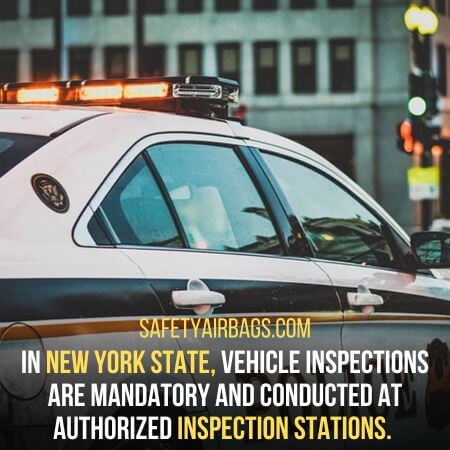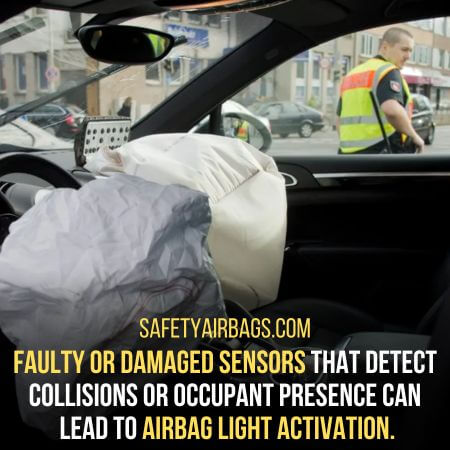Is airbag light part of NYS inspection? Vehicle inspections play a crucial role in ensuring road safety and the overall condition of vehicles.
What Will I learn
- 1 Is airbag light part of NYS inspection?
- 2 Understanding the Airbag System and Its Indicator Light
- 3 Common Causes of Airbag Light Activation
- 4 New York State Inspection Requirements
- 5 Diagnostic and Repair Procedures
- 6 Legal and Safety Implications
- 7 Ensuring Compliance and Addressing Airbag Light Issues
- 8 Conclusion:
Regular inspections can identify and address potential mechanical issues and safety concerns before they pose a risk to the driver, passengers, and other road users.
Is airbag light part of NYS inspection?
The New York State (NYS) vehicle inspection includes various safety-related components, such as brakes, tires, lights, horns, windshield wipers, and emissions.
However, the airbag light is not mentioned as a requirement for inspection in NYS.
Overview Of New York State Inspections:
Inspections help maintain vehicle performance, reduce the likelihood of accidents, and promote compliance with regulations.
In New York State, vehicle inspections are mandatory and conducted at authorized inspection stations.

The inspections ensure that vehicles meet the state’s required safety and environmental standards.
Airbag Light and Its Significance in Inspections:
The airbag light is an essential indicator on the vehicle dashboard that alerts the driver to any issues with the airbag system.
The airbag system is a critical safety feature that deploys airbags in the event of a collision to protect occupants from severe injuries.
The airbag light indicates a potential problem with the system, which requires attention and resolution.
In the context of New York State inspections, the airbag light holds significant importance.
During the inspection process, the airbag system’s functionality, including the airbag light’s proper functioning, is assessed.
If the airbag light is illuminated or not functioning correctly, it may result in inspection failure.
The airbag light serves as an indicator of potential airbag system malfunctions or issues with associated components.
Its activation can signal problems such as faulty sensors, wiring issues, or problems with the airbag control module.
Addressing these issues is crucial for inspection compliance and ensuring the safety of the vehicle’s occupants in the event of an accident.
Understanding the Airbag System and Its Indicator Light
The airbag system is a critical safety feature in vehicles designed to protect occupants in the event of a collision.
It comprises various components, including airbag modules, sensors, and a control unit.
The purpose of the airbag system is to rapidly deploy airbags to cushion and protect occupants from severe injuries, particularly to the head, chest, and torso.
When a collision occurs, sensors in the vehicle detect the impact and send signals to the control unit.
The control unit then triggers the deployment of airbags within milliseconds, providing a protective barrier between the occupants and hard surfaces within the vehicle.
The functionality of the Airbag Indicator Light
The airbag indicator light, typically located on the vehicle’s dashboard, is an important component of the airbag system.
Its primary function is to provide feedback on the status of the airbag system.
Under normal conditions, the airbag light remains off, indicating the system is operating correctly.
However, if a fault or malfunction occurs within the airbag system, the light will illuminate, signaling the need for inspection and potential repairs.
The activation of the airbag light indicates that there may be a problem with the airbag system or its associated components.
Common Causes of Airbag Light Activation
Several factors can cause the airbag light to activate, indicating a potential issue within the system. Some common causes include:
1. Malfunctioning Sensors: Faulty or damaged sensors that detect collisions or occupant presence can lead to airbag light activation.

2. Wiring Issues: Problems with the electrical wiring connecting the airbag components and the control unit can result in the light illuminating.
3. Airbag Control Module Faults: The control module, responsible for receiving and interpreting sensor data, may experience malfunctions that trigger the airbag light.
4. Previous Repairs or Accidents: Improper repairs or accidents that affected the airbag system’s integrity may cause the light to activate.
New York State Inspection Requirements
New York State inspections are conducted at authorized inspection stations to ensure that vehicles meet safety and environmental standards.
Inspections involve a comprehensive evaluation of various components, including the airbag system.
The inspection process typically includes checking the vehicle’s emissions, brakes, lights, tires, and safety systems to ensure compliance with state regulations.
Inspection Criteria for the Airbag System:
During a New York State inspection, the airbag system is evaluated based on specific criteria to assess its functionality and compliance.
Inspectors typically check for the presence and condition of airbags, the integrity of associated components, and the system’s proper functioning.
Additionally, they examine the airbag control module for any diagnostic trouble codes (DTCs) related to the system’s operation and monitor the status of the airbag indicator light.
Specific Requirements Related to the Airbag Light:
New York State inspections have specific requirements regarding the airbag indicator light.
If the airbag light is illuminated or not functioning correctly, it may result in inspection failure.
Inspectors may also check for signs of tampering or attempts to disable the airbag light, as such actions are prohibited and can lead to inspection failure.
Vehicle owners need to ensure that the airbag light is operating correctly and not indicating any issues with the system to pass the inspection successfully.
Diagnostic and Repair Procedures
When the airbag light is activated, it is crucial to diagnose the underlying cause accurately.
Diagnosing the cause helps identify the specific component or system that requires attention and prevents potential safety risks.
It allows for targeted repairs and ensures the airbag system operates as intended, providing optimal protection to vehicle occupants.
Certified Technicians and Specialized Equipment:
Diagnosing and repairing airbag system issues requires the expertise of certified technicians.
These professionals have the necessary training and knowledge to handle the complexities of the airbag system.

They use specialized diagnostic equipment to retrieve error codes, conduct system tests, and pinpoint the exact cause of the airbag light activation.
Relying on certified technicians ensures accurate diagnostics and proper repairs.
Common Repairs to Address Airbag System Issues
Common repairs to address airbag system issues include:
1. Replacing faulty sensors or repairing damaged wiring connections.
2. It repairs or replaces the airbag control module if it malfunctions.
3. Inspecting and repairing airbag deployment circuits to ensure proper functioning.
4. Addressing issues with seat belt pre-tensioners or other components that interact with the airbag system.
It is important to note that repairs related to the airbag system should be performed by qualified professionals with expertise in handling such systems.
This ensures the repairs are done correctly, maintaining the system’s integrity and effectiveness in protecting vehicle occupants.
Legal and Safety Implications
Meeting the legal requirements regarding airbag system inspection is crucial for vehicle owners.
In New York State, compliance with inspection regulations, including properly functioning the airbag system and indicator light, is mandatory.
Failure to comply can result in penalties, fines, or restrictions on vehicle usage.
Additionally, tampering with the airbag system or disabling the light is illegal and may have serious legal consequences.
It is important to adhere to the established regulations to ensure compliance and avoid legal issues.
Safety Considerations for Vehicle Occupants:
The airbag system plays a critical role in enhancing the safety of vehicle occupants.
It acts as a protective barrier in a collision, reducing the risk of severe injuries or fatalities.
Properly functioning airbags and other safety features contribute to the overall safety of the vehicle’s occupants and increase their chances of survival in accidents.
Ensuring the airbag system is in optimal condition through regular inspections and prompt repairs is essential for the safety and well-being of vehicle occupants.
Role of the Airbag System in Reducing Injuries and Fatalities:
The airbag system has proven effective in reducing the severity of injuries and fatalities in automobile accidents.
By rapidly deploying during a collision, airbags cushion the impact and prevent occupants from striking hard surfaces within the vehicle.

They provide crucial protection to the head, chest, and torso regions, reducing the risk of life-threatening injuries.
Regular inspections and maintenance of the airbag system ensure its proper functioning and enable it to fulfill its life-saving purpose effectively.
Ensuring Compliance and Addressing Airbag Light Issues
Before a New York State inspection, it is essential to ensure that the vehicle’s airbag system is in good working order.
Checking for illuminated airbag lights and addressing potential issues in advance will help avoid inspection failures.
Vehicle owners should also review the inspection requirements and documentation to facilitate a smooth inspection process.
Steps to Address Airbag Light Issues Before the Inspection
If the airbag light is activated, it is recommended to take the following steps before the inspection:
1. Check the vehicle’s owner’s manual for troubleshooting steps or recommendations regarding the airbag system.
2. Inspect the airbag fuse to ensure it is not blown or damaged.
3. Check the connections of the airbag sensors and wiring to ensure they are secure and intact.
If no obvious issues are found, consult a certified technician to diagnose and repair the cause of the airbag light activation.
It is important not to ignore or attempt to disable the airbag light, as it is a critical safety feature.
Prompt attention to any airbag system issues is essential for the safety of vehicle occupants.
Conclusion:
The airbag system is a vital safety feature in vehicles, designed to protect occupants in the event of a collision.
Proper inspection and maintenance of the airbag system, including the functioning of the airbag indicator light, are crucial to ensure its effectiveness and compliance with regulations.
The primary objective of vehicle inspections is to ensure the safety and roadworthiness of vehicles.
Thus, it is possible that a malfunctioning airbag system or an illuminated airbag light could be considered a factor in the inspection process.
However, for specific details regarding New York State inspections, it is best to refer to the guidelines provided by the DMV or consult an authorized inspection station.
